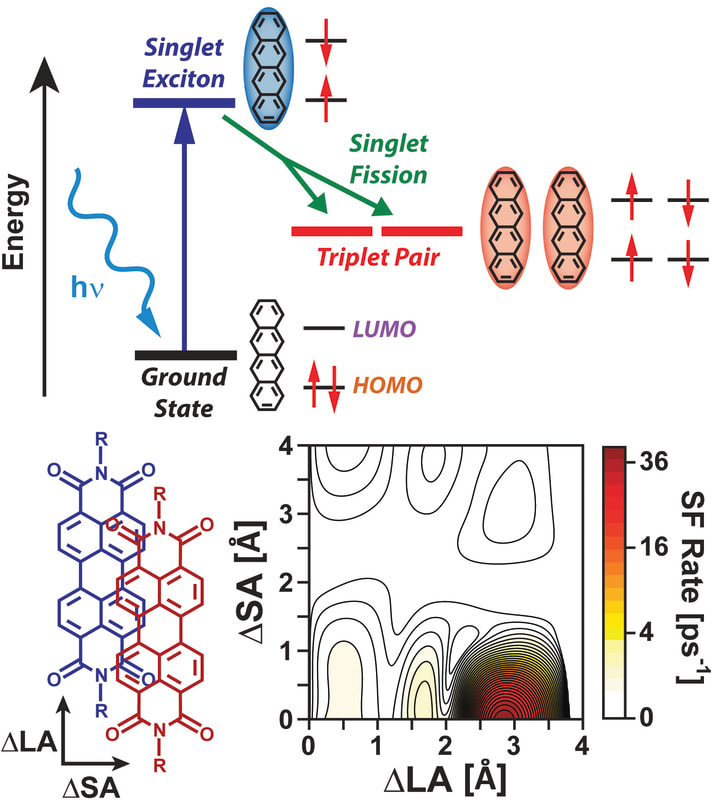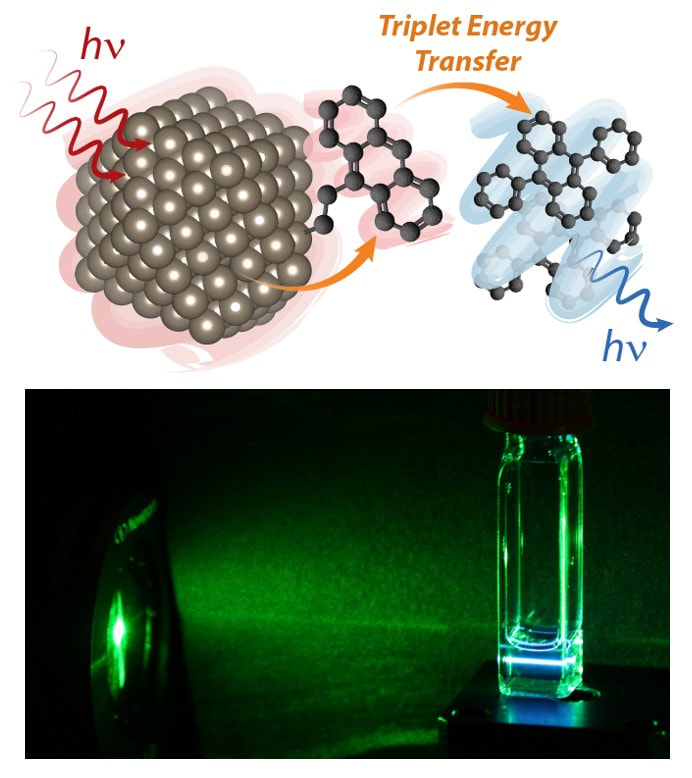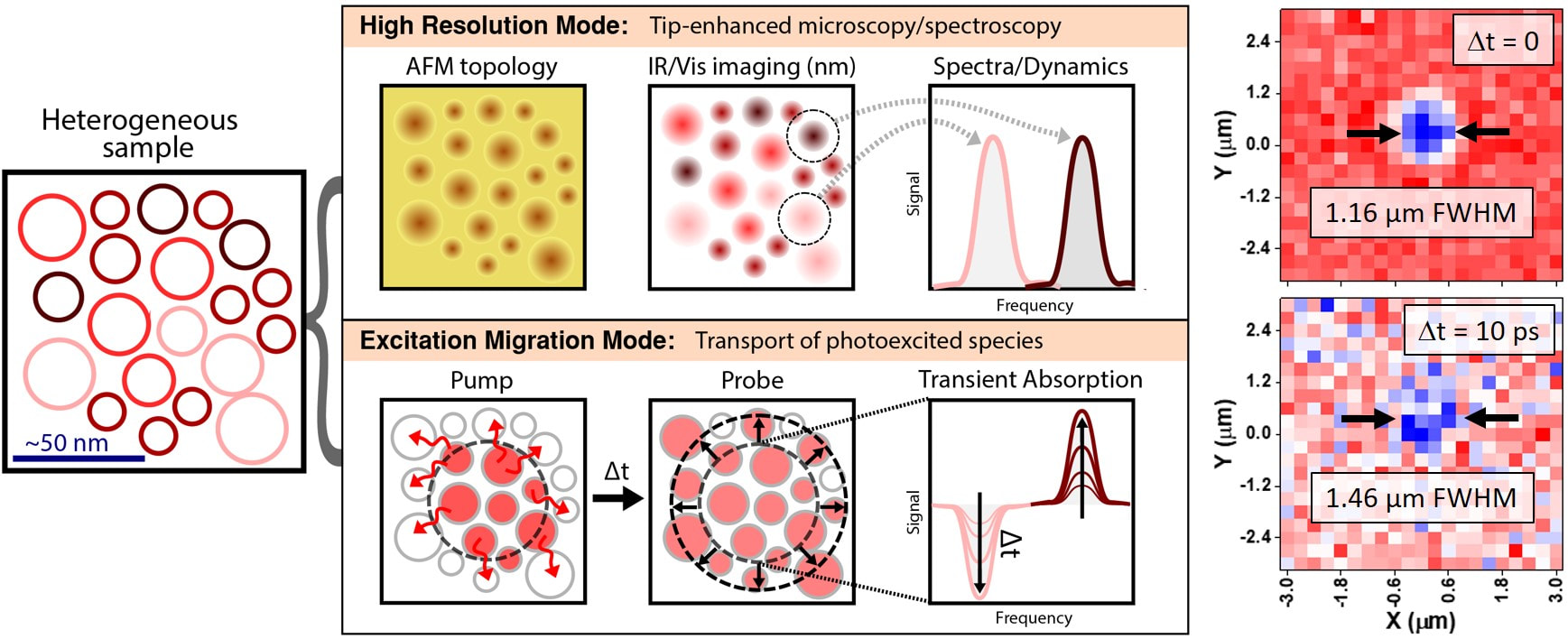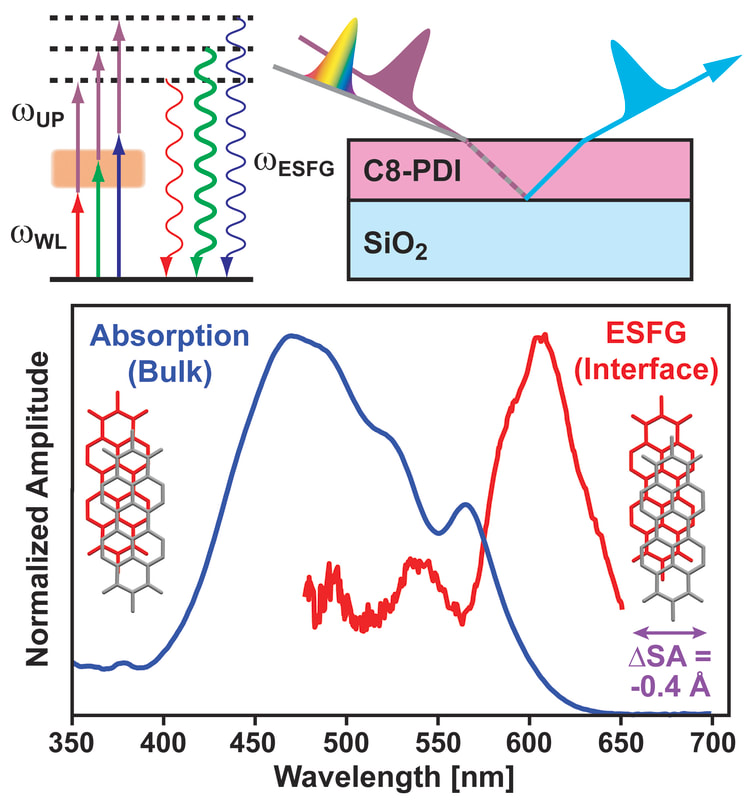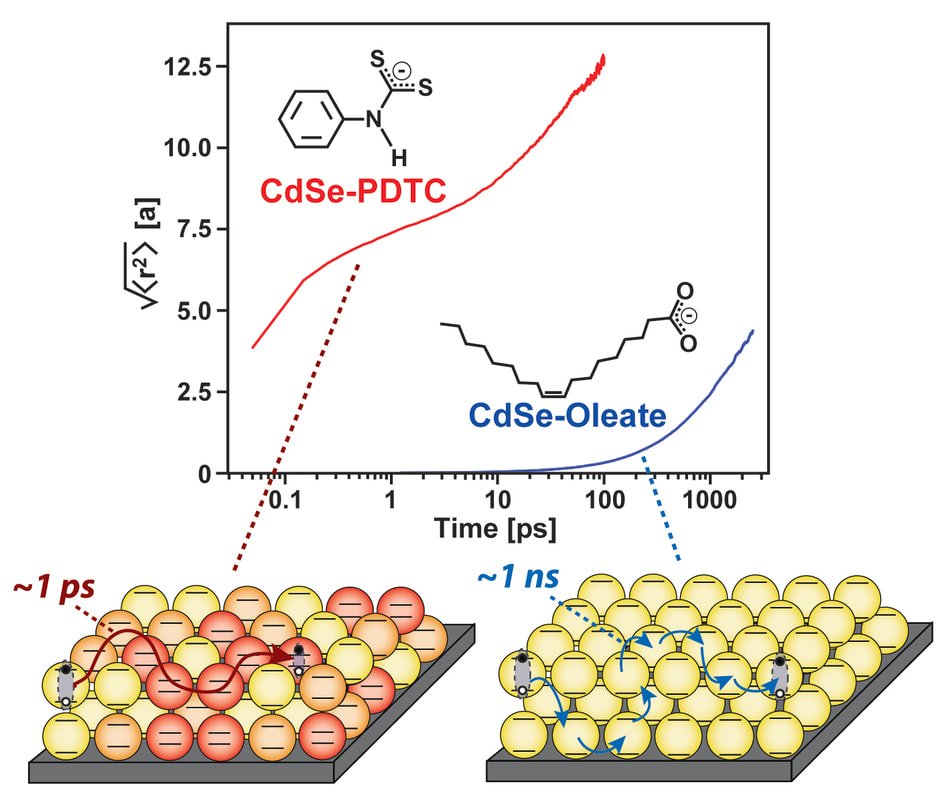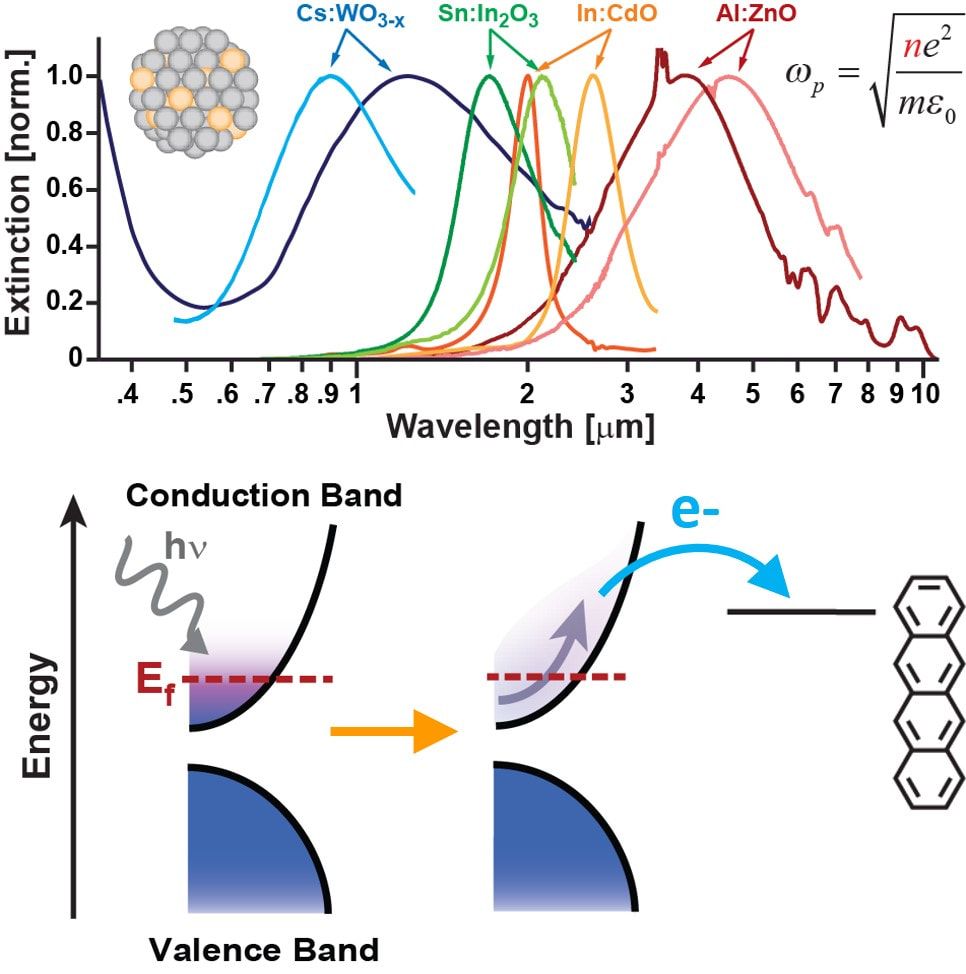Tracking Energy, Charge, and Spin Dynamics in Molecular Materials
Molecular semiconductors are materials whose smallest components are distinct chemical units whose size, shape, and composition can be controlled to achieve a diverse range of functional behavior. Research in the Roberts Group focuses on understanding how the nanoscale organization of these materials dictates how they exchange energy, transport charge, and manipulate electron spin. To accomplish this goal, our group employs and develops time-resolved optical spectroscopies that follow electron behavior on femtosecond-to-millisecond time scales and tens of nanometer-to-millimeter length scales.
Current ongoing projects within our group are described below.
Molecular semiconductors are materials whose smallest components are distinct chemical units whose size, shape, and composition can be controlled to achieve a diverse range of functional behavior. Research in the Roberts Group focuses on understanding how the nanoscale organization of these materials dictates how they exchange energy, transport charge, and manipulate electron spin. To accomplish this goal, our group employs and develops time-resolved optical spectroscopies that follow electron behavior on femtosecond-to-millisecond time scales and tens of nanometer-to-millimeter length scales.
Current ongoing projects within our group are described below.
|
Singlet Fission Materials for Energy Downconversion
Singlet fission is a process wherein a photoexcited molecule in an organic crystal, polymer, or oligomer shares its energy with a neighboring molecule, placing both in an excited spin-triplet state. This triplet pair state is unique in that it can be prepared by absorbing a single photon yet the state contains a pair of excited electrons. This creates unique opportunities to use these states to boost the photocurrent produced by light harvesting systems and to enable multielectron redox reactions without needing to stabilize radical intermediates. Our group works on uncovering design principles for producing singlet fission materials with several desirable properties, such as robust photostability, high molar extinction, and the ability to transport energy over long distances. Critically, we also work on interfacing these materials with inorganic semiconductors, such as silicon, to enable singlet fission-based optoelectronics. |
T. S. Volek, Z. T. Armstrong, J. K. Sowa, K. S. Wilson, M. Bohlmann Kunz, K. Bera, M. Koble, R. R. Frontiera, P. J. Rossky, M. T. Zanni, & S. T. Roberts, “Structural Disorder at the Edges of Rubrene Crystals Enhances Singlet Fission” J. Phys. Chem. Lett. (2023), DOI: 10.1021/acs.jpclett.3c02845
D. E. Cotton, A. P. Moon, & S. T. Roberts, “Using Electronic Sum-Frequency Generation to Analyze the Interfacial Structure of Singlet Fission-Capable Perylenediimide Thin Films” J. Phys. Chem. C 124(21), 11401-13, (2020).
A. K. Le, J. A. Bender, D. H. Arias, D. E. Cotton, J. C. Johnson, & S. T. Roberts, "Singlet Fission Involves an Interplay Between Energetic Driving Force and Electronic Coupling in Perylenediimide Films" J. Am. Chem. Soc. 140(2), 814-26, (2018).
A. K. Le, J. A. Bender, & S. T. Roberts, "Slow Singlet Fission Observed in a Perylenediimide Thin Film" J. Phys. Chem. Lett. 7, 4922-28, (2016).
Supported by the Welch Foundation and W. M. Keck Foundation
D. E. Cotton, A. P. Moon, & S. T. Roberts, “Using Electronic Sum-Frequency Generation to Analyze the Interfacial Structure of Singlet Fission-Capable Perylenediimide Thin Films” J. Phys. Chem. C 124(21), 11401-13, (2020).
A. K. Le, J. A. Bender, D. H. Arias, D. E. Cotton, J. C. Johnson, & S. T. Roberts, "Singlet Fission Involves an Interplay Between Energetic Driving Force and Electronic Coupling in Perylenediimide Films" J. Am. Chem. Soc. 140(2), 814-26, (2018).
A. K. Le, J. A. Bender, & S. T. Roberts, "Slow Singlet Fission Observed in a Perylenediimide Thin Film" J. Phys. Chem. Lett. 7, 4922-28, (2016).
Supported by the Welch Foundation and W. M. Keck Foundation
K. Wang, R. P. Cline, J. Schwan, J. M. Strain, S. T. Roberts, L. Mangolini, J. D. Eaves, & M. L. Tang, "Efficient Photon Upconversion Enabled by Strong Coupling Between Silicon Quantum Dots and Anthracene" Nat. Chem. 15, 1172-78, (2023), Press Release.
D. M. Cadena, J. K. Sowa, D. E. Cotton, C. D. Wight, C. L. Hoffman, H. R. Wagner, J. T. Boette, E. K. Raulerson, B. L. Iverson, P. J. Rossky, & S. T. Roberts, “Aggregation of Charge Acceptors on Nanocrystal Surfaces Alters Rates of Photoinduced Electron Transfer” J. Am. Chem. Soc. 144(49), 22676-88, (2022). Press Release.
E. K. Raulerson, D. M. Cadena, M. A. Jabed, C. D. Wight, I. Lee, H. R. Wagner, J. T. Brewster, B. L. Iverson, S. Kilina, & S. T. Roberts, “Using Spectator Ligands to Enhance Nanocrystal-to-Molecule Electron Transfer” J. Phys. Chem. Lett. 13, 1416-23, (2022).
T. Huang, T. T. Koh, J. Schwan, T. Tran, P. Xia, K. Wang, L. Mangolini, M. L. Tang, & S. T. Roberts, “Bidirectional Triplet Exciton Transfer Between Silicon Nanocrystals and Perylene” Chem. Sci., 12, 6737-46,(2021).
P. Xia, E. K. Raulerson, D. Coleman, C. S. Gerke, L. Mangolini, M. L. Tang, & S. T. Roberts, "Achieving Spin-triplet Exciton Transfer between Silicon and Molecular Acceptors for Photon Upconversion" Nat. Chem. 12, 137-44, (2020). Press Release.
J. A. Bender, E. K. Raulerson, X. Li, T. Goldzak, P. Xia, T. Van Voorhis, M. L. Tang, & S. T. Roberts, "Surface States Mediate Triplet Energy Transfer in Nanocrystal-Acene Composite Systems" J. Am. Chem. Soc., 140(24), 7543-53, (2018).
Supported by the National Science Foundation (CHE-2003735).
D. M. Cadena, J. K. Sowa, D. E. Cotton, C. D. Wight, C. L. Hoffman, H. R. Wagner, J. T. Boette, E. K. Raulerson, B. L. Iverson, P. J. Rossky, & S. T. Roberts, “Aggregation of Charge Acceptors on Nanocrystal Surfaces Alters Rates of Photoinduced Electron Transfer” J. Am. Chem. Soc. 144(49), 22676-88, (2022). Press Release.
E. K. Raulerson, D. M. Cadena, M. A. Jabed, C. D. Wight, I. Lee, H. R. Wagner, J. T. Brewster, B. L. Iverson, S. Kilina, & S. T. Roberts, “Using Spectator Ligands to Enhance Nanocrystal-to-Molecule Electron Transfer” J. Phys. Chem. Lett. 13, 1416-23, (2022).
T. Huang, T. T. Koh, J. Schwan, T. Tran, P. Xia, K. Wang, L. Mangolini, M. L. Tang, & S. T. Roberts, “Bidirectional Triplet Exciton Transfer Between Silicon Nanocrystals and Perylene” Chem. Sci., 12, 6737-46,(2021).
P. Xia, E. K. Raulerson, D. Coleman, C. S. Gerke, L. Mangolini, M. L. Tang, & S. T. Roberts, "Achieving Spin-triplet Exciton Transfer between Silicon and Molecular Acceptors for Photon Upconversion" Nat. Chem. 12, 137-44, (2020). Press Release.
J. A. Bender, E. K. Raulerson, X. Li, T. Goldzak, P. Xia, T. Van Voorhis, M. L. Tang, & S. T. Roberts, "Surface States Mediate Triplet Energy Transfer in Nanocrystal-Acene Composite Systems" J. Am. Chem. Soc., 140(24), 7543-53, (2018).
Supported by the National Science Foundation (CHE-2003735).
Spatially Resolving Nanoscale Energy Transfer
Molecular materials such as solids composed of singlet fission/triplet fusion-capable molecules, nanocrystal superlattices, or polymers films, form structures that are often ordered on short length scales (1 – 100 nm) but form disordered networks over longer distances. Understanding how disorder imposed by defects, grain boundaries, and other structural features acts to inhibit or enable the function of these materials requires experiments that can probe the motion of electrons and nuclei on femtosecond-to-nanosecond time scales with a spatial resolution on the nanometer scale. To meet this goal, our group is working to develop a transient absorption microscope with spectral tunability from the near-UV to the mid-IR that obtains high spatial resolution via integration of a scanning probe tip.
Molecular materials such as solids composed of singlet fission/triplet fusion-capable molecules, nanocrystal superlattices, or polymers films, form structures that are often ordered on short length scales (1 – 100 nm) but form disordered networks over longer distances. Understanding how disorder imposed by defects, grain boundaries, and other structural features acts to inhibit or enable the function of these materials requires experiments that can probe the motion of electrons and nuclei on femtosecond-to-nanosecond time scales with a spatial resolution on the nanometer scale. To meet this goal, our group is working to develop a transient absorption microscope with spectral tunability from the near-UV to the mid-IR that obtains high spatial resolution via integration of a scanning probe tip.
T. S. Volek, Z. T. Armstrong, J. K. Sowa, K. S. Wilson, M. Bohlmann Kunz, K. Bera, M. Koble, R. R. Frontiera, P. J. Rossky, M. T. Zanni, & S. T. Roberts, “Structural Disorder at the Edges of Rubrene Crystals Enhances Singlet Fission” J. Phys. Chem. Lett. (2023), DOI: 10.1021/acs.jpclett.3c02845
N. Gross, C. T. Kuhs, B. Ostovar, W.-Y. Chiang, K. S. Wilson, T. S. Volek, Z. M. Faitz, C. C. Carlin, J. A. Dionne, M. T. Zanni, M. Gruebele, S. T. Roberts, S. Link, & C. F. Landes, “Progress and Prospects in Optical Ultrafast Microscopy: Transient Absorption and Two-Dimensional Spectroscopy” J. Phys. Chem. C. 127(30), 14557-86, (2023).
Supported by the Center for Adopting Flaws as Features, a NSF CCI (CHE-2124983), with additional equipment support from the National Science Foundation (CHE-2019083)
N. Gross, C. T. Kuhs, B. Ostovar, W.-Y. Chiang, K. S. Wilson, T. S. Volek, Z. M. Faitz, C. C. Carlin, J. A. Dionne, M. T. Zanni, M. Gruebele, S. T. Roberts, S. Link, & C. F. Landes, “Progress and Prospects in Optical Ultrafast Microscopy: Transient Absorption and Two-Dimensional Spectroscopy” J. Phys. Chem. C. 127(30), 14557-86, (2023).
Supported by the Center for Adopting Flaws as Features, a NSF CCI (CHE-2124983), with additional equipment support from the National Science Foundation (CHE-2019083)
|
Building New Optical Probes for Studying Buried Interfaces
While energy transport within molecular materials is key to their function, equally important are the interfaces they form with other compounds as these regions often serve a critical role in energy and charge extraction. Unfortunately, probing such regions experimentally is challenging as optical spectroscopies such as absorption and emission typically report on a material’s bulk rather than its interfaces while scanning probe measurements such as AFM and STM require exposed surfaces. To address this issue, we work to develop optical methods based on electronic sum frequency generation (ESFG) spectroscopy, which produces signals that emanate from regions of a sample that lack inversion symmetry. As interfaces naturally lack such symmetry, ESFG provides a means for selectively probing these key regions. |
D. E. Cotton & S. T. Roberts, “Sensitivity of Sum Frequency Generation Experimental Conditions to Thin Film Interference Effects” J. Chem. Phys., 154, 114704, (2021).
D. E. Cotton, A. P. Moon, & S. T. Roberts, “Using Electronic Sum-Frequency Generation to Analyze the Interfacial Structure of Singlet Fission-Capable Perylenediimide Thin Films” J. Phys. Chem. C 124(21), 11401-13, (2020).
A. P. Moon, R. Pandey, J. A. Bender, D. E. Cotton, B. A. Renard, & S. T. Roberts, "Using Heterodyne-Detected Electronic Sum Frequency Generation to Probe the Electronic Structure of Buried Interfaces" J. Phys. Chem. C. 121(34), 18653-64, (2017).
R. Pandey, A. P. Moon, J. A. Bender, & S. T. Roberts, "Extracting the density of states of copper phthalocyanine at the SiO2 interface with electronic sum frequency generation" J. Phys. Chem. Lett. 7(6), 1060-66, (2016).
Supported by the National Science Foundation (CHE-1654404).
D. E. Cotton, A. P. Moon, & S. T. Roberts, “Using Electronic Sum-Frequency Generation to Analyze the Interfacial Structure of Singlet Fission-Capable Perylenediimide Thin Films” J. Phys. Chem. C 124(21), 11401-13, (2020).
A. P. Moon, R. Pandey, J. A. Bender, D. E. Cotton, B. A. Renard, & S. T. Roberts, "Using Heterodyne-Detected Electronic Sum Frequency Generation to Probe the Electronic Structure of Buried Interfaces" J. Phys. Chem. C. 121(34), 18653-64, (2017).
R. Pandey, A. P. Moon, J. A. Bender, & S. T. Roberts, "Extracting the density of states of copper phthalocyanine at the SiO2 interface with electronic sum frequency generation" J. Phys. Chem. Lett. 7(6), 1060-66, (2016).
Supported by the National Science Foundation (CHE-1654404).
|
Enabling Quantum Dot Photoinduced Charge Transfer with Exciton Delocalizing Ligands
Due to their size-tunable optical and electronic properties, quantum dots an attractive platform for solar cells, photocatalysts, and light sensors. Employing quantum dots for these applications requires that they be able to readily transmit charge to their environment following dot photoexcitation. To aid in this process, our group investigates exciton-delocalizing ligands, which are molecules that have the proper electronic structure and symmetry to allow strong mixing of their valence orbitals with quantum dot band edge states. This relaxes the confinement of photoexcited charges and makes photogenerated carriers more readily transferable to their environment. |
M. S. Azzaro, A. K. Le, H. Wang, & S. T. Roberts, "Ligand-Enhanced Energy Transport in Nanocrystal Solids Viewed with Two-Dimensional Electronic Spectroscopy" J. Phys. Chem. Lett. 10, 5602-08, (2019).
M. S. Azzaro, A. Dodin, D. Y. Zhang, A. P. Willard, & S. T. Roberts, "Exciton-Delocalizing Ligands Can Speed Up Energy Migration in Nanocrystal Solids" Nano Letters, 18(5), 3259-70, (2018).
M. S. Azzaro, M. C. Babin, S. K. Stauffer, G. Henkelman, & S. T. Roberts, "Can Exciton-delocalizing Ligands Facilitate Hot Hole Transfer from Semiconductor Nanocrystals?" J. Phys. Chem. C. 120(49), 28224-34, (2016).
Supported by the Alfred P. Sloan Foundation
M. S. Azzaro, A. Dodin, D. Y. Zhang, A. P. Willard, & S. T. Roberts, "Exciton-Delocalizing Ligands Can Speed Up Energy Migration in Nanocrystal Solids" Nano Letters, 18(5), 3259-70, (2018).
M. S. Azzaro, M. C. Babin, S. K. Stauffer, G. Henkelman, & S. T. Roberts, "Can Exciton-delocalizing Ligands Facilitate Hot Hole Transfer from Semiconductor Nanocrystals?" J. Phys. Chem. C. 120(49), 28224-34, (2016).
Supported by the Alfred P. Sloan Foundation
|
Exploring Near-Infrared Plasmonic Nanocrystals for Optoelectronics and Reconfigurable Structures
Metal nanocrystals are known for their ability to support localized surface plasmon resonances that enable an external electric field to excite a collective motion of the particle’s free charge carriers. When dissipated, the plasmon's energy can drive photoinduced charge transfer, local heating, and other processes. While the metal plasmon resonances show limited chemical tunability, highly-doped metal oxide particles can be used to produce plasmonic materials with resonances tunable throughout the visible and infrared. In collaboration with the Milliron group, we are using ultrafast spectroscopy to understand how these materials exchange energy and charge with their environment to design optoelectronic applications that take advantage of their unique chemical tunability. |
M. A. Blemker, S. L. Gibbs, E. K. Raulerson, D. J. Milliron, & S. T. Roberts, “Modulation of the Visible Absorption and Reflection Profiles of ITO Nanocrystal Thin Films by Plasmon Excitation” ACS Photonics. 7(5), 1188-96, (2020).
R. W. Johns, M. A. Blemker, M. S. Azzaro, S. Heo, E. L. Runnerstrom, D. J. Milliron, & S. T. Roberts, "Charge Carrier Concentration Dependence of Ultrafast Plasmonic Relaxation in Conducting Metal Oxide Nanocrystals" J. Mater. Chem. C. 5, 5757-63, (2017).
Supported by Center for Dynamics and Control of Materials, a NSF MRSEC (DMR-2308817)
R. W. Johns, M. A. Blemker, M. S. Azzaro, S. Heo, E. L. Runnerstrom, D. J. Milliron, & S. T. Roberts, "Charge Carrier Concentration Dependence of Ultrafast Plasmonic Relaxation in Conducting Metal Oxide Nanocrystals" J. Mater. Chem. C. 5, 5757-63, (2017).
Supported by Center for Dynamics and Control of Materials, a NSF MRSEC (DMR-2308817)

